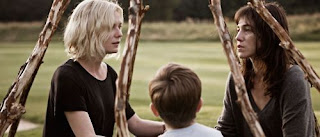Melancholia had its Los Angeles premiere at the Egyptian Theatre in Hollywood last night, as part of this years AFI Film Festival. People stood in line for hours in hopes to experience a unique cinematic spectacle that would foray outside their comfort zones. A hush came over the room as a gushing Kirsten Dunst took the stage to introduce the film with her co-star, Udo Kier. Mrs. Dunst beamed proudly as she waved to friends and family in the audience and the lights slowly dimmed to blackness. Her smiling face only seconds before sharply contrasts to the film's opening montage, a sequence of slow moving shots of her face, absentmindedly unaware of the destruction taking place behind her. Dead birds are falling gracefully in slow motion as Kirsten tries to open her eyes. This is a stark image to initiate the viewer in von Trier's film but, as we will later discover, we will spend the next two hours as Kirsten spends the first two minutes, alone, trying to open our eyes to the world around us.
The film begins with an overture of images combined with Wagners' compositions from Tristan and Isolde. The epic scale of the images complements the grand operatic score. These opening images allow us to step outside the realm of a created reality and into a dreamlike space where the events of the film are foreshadowed in slow motion, encouraging the viewer to cement these destructive moments in their mind before the film thrusts forward into it's spiraling narrative. These moments are gorgeous interludes that allow the viewer, at the onset of the film, to mediate on the end of the world and the moments that encapsulate it.
The film is broken into two additional parts: Justine (Kirsten Dunst, who hasn't stolen the screen since her indelible performance in Sofia Coppola's The Virgin Suicides) and her sister Claire (played with perfect insecurity by Charlotte Gainsbourg). Justine's section takes place at her wedding reception; a dream world where all the guests are found inside a remote castle to celebrate an occasion that doesn't seem to be happy for anyone. This is the place where we are taken inside Justine's character and shown the darkness that is bubbling underneath. Dunst plays this role with perfectly nuanced moments of despair and longing fused with a slighted air of ineffectual happiness. We see her world crumbling around her elusive nature and this normally wonderful occasion is tainted with distain from beginning to the bitter end. This is the segment where we see Justine's happiness fade in a mere matter of moments into a fragmented series of moments that shred her character into pieces.
The second part of the narrative, follows Claire and the imminent disaster that awaits the planet. A newly discovered planet called Melancholia is on a crash course with Earth and the family is forced to, each in their own way, come to terms with the loss of everything. This part of the film is the most interesting to the viewer as it sets the stage for the disaster that the film's introduction already alluded to. The world is going to be disintegrated but how will these four people choose to deal with that reality is what interests von Trier.
The film's final moment in a field on a hilltop near the house allow us unique access to the mind of each of von Trier's characters. Hiding in plain sight from the looming planet, Justine tells her sister and her son to take her hand and close their eyes. As the camera moves to and from each of the three characters only the son, Leo (played brilliantly by Cameron Spurr) keeps his eyes closed, a image of placid childlike wonder on his face until the very end. Justine, intent on losing her grip on reality from the beginning, opens her eyes but her back remains toward the planet on the horizon. Justine, fearful of the world around her, fearful of all she has to lose, recoils from her son and sister and stares horrified into her fate.
This only being my second Lars Von Trier viewing, the other being his Dancer in the Dark (2000), I was expecting the violence that explodes at the end but the quiet surrender and total alienation of that destruction left me feeling hungry for the world outside the dark theater walls.
Justine in her moment of seclusion away from everyone else at her wedding
A dream that Justine alludes to later in the film, this image is from the beginning montage
Justine and her new husband, desperately clinging to a false reality.
One of the first hints of impending doom, a snow shower.
The first image of Justine on screen, trying to open her eyes.
The three main characters in the film's beginning montage with Melancholia behind them
An image from the film's final moment, hiding in plain sight from imminent destruction







No comments:
Post a Comment